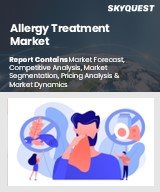
알레르기 치료제 세계 시장 규모는 2023년에 225억 달러로 평가되었으며, 2024년 241억 달러에서 2032년에는 417억 1,000만 달러로 성장하여 예측 기간(2025-2032년) 동안 CAGR 7.1%로 성장할 전망입니다.
세계 알레르기 치료제 시장은 알레르기 유병률 증가, 인식 제고, 적절한 치료를 촉진하기 위한 정부 및 NGO의 지원 이니셔티브에 힘입어 강력한 성장세를 보이고 있습니다. 면역 치료의 기술 발전과 맞춤형 의료의 부상으로 시장을 더욱 촉진하고 있습니다. 또한, 일반의약품(OTC) 수요 증가, 의료비 지출 확대, 노인 인구 증가, 천식 환자 급증 등이 주요 성장 촉진요인으로 작용하고 있습니다. 특히, 설하 면역요법(SCIT) 분야는 면역 증강 효과와 전신성 완화 효과로 인해 견인력을 얻고 있으며, Journal of Allergy and Clinical Immunology 저널의 2024년 연구는 알레르기 비염 치료에 미치는 영향을 강조하고 있습니다. 하지만, 고가의 치료 비용과 보험 적용이 되지 않는 것은 저소득 지역에서는 큰 장벽으로 작용하고 있습니다.
Global Allergy Treatment Market size was valued at USD 22.5 billion in 2023 and is poised to grow from USD 24.1 billion in 2024 to USD 41.71 billion by 2032, growing at a CAGR of 7.1% during the forecast period (2025-2032).
The Global Allergy Treatment Market is experiencing robust growth, fueled by rising allergy prevalence, growing awareness, and supportive initiatives from governments and NGOs aimed at promoting proper treatment. Technological advancements in immunotherapy and the rise of personalized medicine are further boosting the market. Additionally, increasing demand for over-the-counter (OTC) medications, expanding healthcare expenditure, a growing elderly population, and the surge in asthma cases are key growth drivers. Notably, the sublingual immunotherapy (SCIT) segment is gaining traction due to its immune-boosting benefits and systemic relief, with a 2024 study in the Journal of Allergy and Clinical Immunology emphasizing its impact in treating allergic rhinitis. However, high costs of advanced therapies and lack of insurance coverage pose significant barriers in low-income regions.
Top-down and bottom-up approaches were used to estimate and validate the size of the Global Allergy Treatment market and to estimate the size of various other dependent submarkets. The research methodology used to estimate the market size includes the following details: The key players in the market were identified through secondary research, and their market shares in the respective regions were determined through primary and secondary research. This entire procedure includes the study of the annual and financial reports of the top market players and extensive interviews for key insights from industry leaders such as CEOs, VPs, directors, and marketing executives. All percentage shares split, and breakdowns were determined using secondary sources and verified through Primary sources. All possible parameters that affect the markets covered in this research study have been accounted for, viewed in extensive detail, verified through primary research, and analyzed to get the final quantitative and qualitative data.
Global Allergy Treatment Market Segments Analysis
Global Allergy Treatment Market is segmented by Type, Treatment, Route of Administration, End-Users, Distribution Channel and region. Based on Type, the market is segmented into Eye Allergy, Food Allergy, Skin Allergy, Asthma, Rhinitis and Others. Based on Treatment, the market is segmented into Anti-Allergy Drugs and Immunotherapy. Based on Route of Administration, the market is segmented into Oral, Inhalation, Intranasal and Others. Based on End-Users, the market is segmented into Hospitals, Specialty Clinics, Homecare and Others. Based on Distribution Channel, the market is segmented into Hospital Pharmacy, Retail Pharmacy, Online Pharmacy and Others. Based on region, the market is segmented into North America, Europe, Asia Pacific, Latin America and Middle East & Africa.
Driver of the Global Allergy Treatment Market
The Global Allergy Treatment market is experiencing substantial growth driven by the increasing prevalence of allergic conditions such as food allergies, atopic dermatitis, allergic rhinitis, and asthma. This surge in demand can be linked to various factors, including dietary changes, climate change, environmental pollution, and urbanization, which are collectively enhancing immune hypersensitivity. Additionally, the introduction of advanced drug formulations that specifically target allergic responses and address long-term management needs further propels market expansion. Notably, the 2024 report from the Centers for Disease Control and Prevention (CDC) highlighted that over 25 million Americans suffer from asthma and roughly 1 in 13 children face food allergies, intensifying the need for effective allergy treatment medications and devices, particularly corticosteroids, leukotriene inhibitors, and antihistamines.
Restraints in the Global Allergy Treatment Market
The Global Allergy Treatment market faces significant restraints due to the high costs associated with targeted therapies, particularly allergen immunotherapies and monoclonal antibodies, which hinder their uptake in middle- and low-income countries. While these treatments demonstrate enhanced clinical efficacy, the ongoing affordability gap restricts access, especially in areas with inadequate insurance coverage. This financial barrier negatively affects market penetration and patient adherence to allergy treatments, ultimately impeding consistent growth across the global landscape. As a result, the disparity in accessibility given economic constraints remains a critical challenge that the allergy treatment market must address to ensure widespread adoption.
Market Trends of the Global Allergy Treatment Market
The Global Allergy Treatment market is experiencing a notable shift as Sublingual Immunotherapy (SLIT) emerges as a preferred choice over traditional injectable therapies. In 2024, there has been a marked increase in the adoption of SLIT, particularly among pediatric and geriatric populations who favor its oral, pain-free administration. This trend is particularly evident in countries like France and South Korea, where SLIT's ease of use and reduced need for clinical supervision have spurred rapid market growth. As patients increasingly prioritize convenience and comfort in their treatment options, SLIT is poised to reshape the allergy management landscape globally, driving further innovations in therapeutic delivery methods.